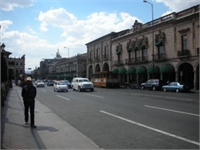
A Brief Introduction to Michoacán, Mexíco
Important Notice: Our web hosting provider recently started charging us for additional visits, which was unexpected. In response, we're seeking donations. Depending on the situation, we may explore different monetization options for our Community and Expert Contributors. It's crucial to provide more returns for their expertise and offer more Expert Validated Answers or AI Validated Answers. Learn more about our hosting issue here.

A Brief Introduction to Michoacán, Mexíco
You must be logged in to post a comment.
Known as the “place of fishermen” in Nahuatl, the state of Michoacán, Mexico stretches from the far western edge of the state of Mexico to the Pacific Ocean. The topography, flora and fauna are diverse. Sandy beaches, volcanic plateaus, mountains and valleys are all a part of the landscape. The Lake Pátzcuaro Basin contains numerous hot springs.
While the climate is temperate, temperatures do vary according to region. The area known as Tierra Caliente (the hot land) is a semi-arid, hot region. In the mountainous areas, the nighttime winter temperatures drop to around 35 to 40 degrees Fahrenheit. Most years, the rainy season arrives toward the end of May and lasts through September.
The story of Spanish conquest in Michoacán differs from Mexico City (Tenochtitlan.) Prior to the arrival of the Spaniards, constant battles ensued between the Tarascan people of Michoacán and the Mexícas (Aztecs) of Tenochtitlan. Neither group successfully penetrated the territory of the other.
Many different ethnic groups lived within the Tarascan Empire. These ethnic enclaves included Otomies, Nahuas, Chichimec, Uacúsecha and others. The unification of the Tarascan state dates back to the mid-fourteenth century.
In 1522, Cristobal de Olid arrived in the capitol city of Tzintzuntzan. The Spanish conquistador convinced the Tarascan leader to join forces with the Spanish, in order to defeat the Aztecs. Unfortunately, the Tarascans did not realize they too, would succumb to Spanish domination.
Today, Morelia is the capitol city of the state; however, the indigenous peoples originally called it Guayangareo (long and flattened hill.) In 1541, the Spaniards renamed it “City of Mechuacán.” In 1545, the Spanish Viceroy officially named the city, “Valladolid.” In 1824, the city became “Morelia” in honor José Maria Morelos y Pavón.
Michoacán is known for its pueblos of artisans. Bishop Don de Vasco Quiroga is credited with preserving many of the indigenous craft traditions. Quiroga believed the indigenous peoples of the region could become less economically dependent upon the Spaniards, through their crafts. As a result, many pueblos began to specialize in one particular art or craft. This tradition continues today.
Today, the former Tarascan city Pátzcuaro is famous for los dias de los muertos, (days of the dead) celebrations, wooden furniture and fish. The town of Quiroga is world renown for its string instruments. The people of Santa Clara del Cobre, once an important copper mining region now produce copperware. Tzintzuntzan and the surrounding villages specialize in pottery ware. A Tarascan archeological site is also located in Tzintzuntzan.
Michoacán is also home to several Monarch butterfly sanctuaries. Butterflies inhabit the forested areas during the winter months, before heading north to the U.S. and Canada. The area is also a popular bird watching site.
For those who prefer the beach to the mountains, Ixtapa is a good choice. During the 1970’s, the Mexican government began to develop and promote Ixtapa as a beach resort. Today, the city is a popular tourist destination for foreigners, as well as Mexicans.
Michoacán is a good destination for those who wish to avoid the overcrowding of Mexico City. In Morelia, you can find hotels to fit every budget, restaurants, nightclubs and museums. Its central location makes it perfect for day trips to outlying towns.